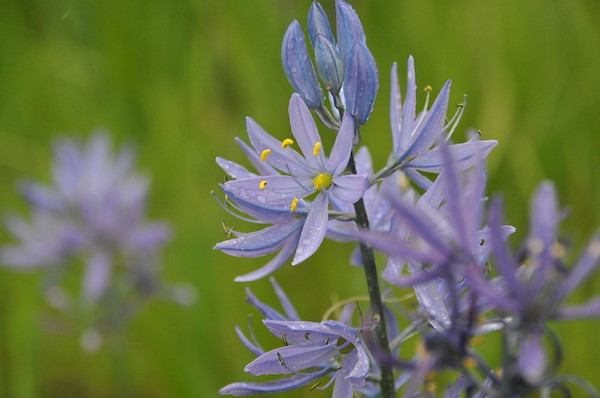SEJournal Online is the digital news magazine of the Society of Environmental Journalists. Learn more about SEJournal Online, including submission, subscription and advertising information.
 |
| Traditional foods, such as bulbs of the common camas, seen above at Marys River Natural Area in Oregon, are now being rediscovered and cultivated for their environmental and health benefits. Camas was an important food source for western North American Indigenous peoples. Photo: USDA/NRCS Oregon via Flickr Creative Commons (CC BY ND 2.0). |
Climate Solutions: Environmental Reporting Through an Indigenous Perspective
By Brian Bull
Whether it’s Native Americans, the First Nations of Canada, Aboriginal Australians or any Indigenous community across the globe, people who’ve lived in balance with their environment have endured oppression and hardship while trying to protect their resources from outside interests.
 |
In the wake of global warming and related hazards, people are beginning to appreciate the sustainable practices demonstrated by many of these so-called “primitive” cultures. For this tipsheet, I’ll stick to my strongest area, which is Native American tribes and groups here in the United States. But enterprising reporters can apply some of the general tips to any number of Indigenous communities they may wish to cover.
Native voices have been largely underrepresented in discussions about environmental responsibility, and what little coverage that’s been given is often dated and stereotypical (think the grunting savage from 1950s Hollywood westerns) or shallow and mystical (what many Indians jokingly call the “plastic shaman” phenomenon). By reaching out with sincere interest and aiming for authenticity, these perspectives can enhance the dialogue on many environmental issues today.
Indigenous practices driven underground
For countless generations, Indigenous people across the continent lived in accordance with the land. The natural world was something to coexist with, rather than conquer. Elements — including fire — were not seen as horrific disasters, but as tools that afforded respect and care.
For roughly 500 years, Indigenous practices and philosophies regarding people’s place on Earth were ignored, ridiculed and driven underground by “civilized” colonists pushing westward across North America.
Government agencies, for instance, began an aggressive campaign of wildfire suppression in the early 20th century, which over time created excess slash, as well as depriving plants and habitats of the very element they needed to rejuvenate (this includes the giant sequoia, whose cones open up and release seeds after exposure to flames).
Add to wildfire the development of dams,
mines, railways and inevitably highways and
the delicate balance of coexistence has become
greatly harmed by mankind’s ‘innovation.’
Add in the development of dams, mines, railways and inevitably highways and the delicate balance of coexistence has become greatly harmed by mankind’s “innovation.” Adding hardship to the Indigenous people was the overhunting of game, the loss of their ancestral lands and the crackdown on their Native ways.
But interest in these principles has seen a resurgence as climate disasters have grown in number and intensity in the last 20 years, including by the same government agencies that suppressed them over the past century.
Today’s journalists, working through many tribal scholars, environmental scientists and practitioners of the “old ways,” can tap into what’s widely become known as “traditional ecological knowledge.”
For the tribes themselves, this is nothing novel or extraordinary; it is insights built by the interconnectedness, from a people whose very existence was integrated with the air they breathed, the waters they swam in, the land they walked upon and the fire they built and controlled for warmth and cooking (incidentally, returning to traditional foods is another movement as the modern American diet — with its fast and processed foods — has proven problematic to say the least).
Solutions to explore
- Many tribes have natural resources of their own to manage, including timber, agricultural development, hatcheries and oil and coal deposits. How do their practices in managing these differ from non-Indian government agencies and corporations?
- Some facilities like dams are being scrutinized, with critics calling for their removal in order to restore natural water flow and the unimpeded migration of culturally significant species like salmon. Proponents of dams counter that they help facilitate cargo shipments and generate hydroelectricity. What are the pros and cons of both sides, and what is likely to be the outcome in certain states and counties?
- There are now efforts to rediscover and cultivate traditional foods as a way to reclaim culture and ward off the negative effects of eating too much processed or fast food. What tribes or Native organizations are planting gardens and educating members about the foods their ancestors ate? Can experts like nutritionists, dieticians or ecologists describe the benefits of raising these foods, for both the environment and the consumer? (Maybe compare the resources that go into making a pound of beef versus an acre of camas.)
- Modern American planning puts cities close to beaches and rivers, which puts them in harm's way during severe weather like hurricanes and floods. Ancient Indigenous villages were often kept near — but above — waterways to help reduce the effects of such disasters. Are there methods and strategies that today’s city planners and architects can learn from this traditional ecological knowledge?
Native people all across the continent were
adept at controlled burns, used in order to
replenish or strengthen certain plants.
- Native people all across the continent were adept at controlled burns, used in order to replenish or strengthen certain plants. Are tribes in your area revisiting these burns, and are non-Indian agencies taking note? (I did this story myself for public radio station KLCC last year, and it has proven to be one of the most popular I’ve filed.)
- As Indigenous people try to restore numbers of culturally-relevant fish, animals and plants, they are encountering firsthand the effects of colonization. As recently as early October, the Oregon Health Authority issued an advisory for lamprey in the Columbia River after finding PCBs and mercury in several of them. Limits on consumption have been issued while at the same time a number of regional Native American tribes are working to increase the lamprey’s numbers. Are there similar conflicts happening in your region?
Reporting resources
- Native American Journalists Association: While not devoted entirely to environmental coverage per se, NAJA has many reporting guides that are good for helping reporters — especially non-Indians — understand best practices when working with tribal communities and issues. Style guides, primers and insightful articles are intended to help avoid clichéd or stereotypical coverage, and also focus on positive aspects versus “doom and gloom” reporting.
- The National Congress of American Indians: This organization has online documentation outlining important cases involving resource management and protection. As a repository of relevant information, it is a good place to explore story ideas and potential sources (although be aware that it is not great at returning calls or emails).
- Traditional ecological knowledge tipsheet: Prepared by the U.S. Fish & Wildlife Service with the input of tribal liaisons and consultants, this five-page document gives a concise but comprehensive overview of traditional ecological knowledge. Better yet, it lists various groups and references that can help journalists track down further information and story possibilities.
- Frontiers in Ecology and the Environment: “Contributions of Indigenous Knowledge to ecological and evolutionary understanding”: A more scholarly deep dive into the world of Indigenous knowledge that shows the intersections of where modern science and Indigenous practices overlap, and how Western researchers are beginning to recognize and adopt Indigenous knowledge in a number of fields.
- Ensia: “These Indigenous Educators Are Bringing Western and Native Science Together in the Classroom”: A great summary article, published in a solutions-based journal from the University of Minnesota’s Institute on the Environment, on how Native and Western environmental practices can intersect, even complement, each other rather than be in conflict. Many notable scholars mentioned here can be important sources or references.
- National Museum of the American Indian: Responses to environmental challenges: This site was developed between the NAMI and four North American tribes, who are contending with environmental challenges: the Lummi, who are working to save their salmon; the Leech Lake Ojibwe, who are exploring how best to protect wild rice, a traditional staple; the Akwesasne Mohawk, who are protecting the threatened black ash tree that is essential for their baskets; and the Campo Kumeyaay, who are developing ways to restore water to an area harmed by cattle grazing.
- Center for Indigenous Environmental Resources: A First Nations site outlining important projects involving renewable energy, food sovereignty and biodiversity conservation, all incorporating Indigenous knowledge.
- Native American Environmental Protection Coalition: A California-based, nonprofit group dedicated to providing technical assistance, environmental education, professional training, information networking and intertribal coordination for interested tribes in the spirit of tribal sovereignty. Programs include helping tribes acquire clean vehicles, or undergo hazardous waste operations and emergency response, or HAZWOPER training.
- Indigenous Environmental Network: Developed in 1990 by a grassroots gathering of Indigenous activists and leaders, IEN was designed to discuss common experiences regarding environmental assaults on Indigenous lands, waters, communities and villages. According to IEN, at that time, a significant number of our tribal communities and villages were targeted for large toxic municipal and hazardous waste dumps and nuclear waste storage facilities, “with industrial and mineral development in Indian country literally leaking and oozing out of the ground with toxic poisons.” Since then, IEN has expanded its alliances and now coordinates programs including carbon trading and offsets, and has helped organize against major pipeline projects such as Keystone XL and the Dakota Access Pipeline.
[Editor’s Note: For more resources on nature-based solutions, as part of the Covering Climate Solutions special report, see our toolbox on nature-based and native/Indigenous perspectives. Also from the SEJournal, read Backgrounders on how Native tribal nations are pushing for changes in public lands and on finding Native people at the heart of the environment beat. In addition, check out a 2020 Society of Environmental Journalists workshop, which offered a resource guide, and an all-day 2019 SEJ workshop on “Covering Indian Country, Public Lands and Environmental Justice in the West,” which includes session recordings. Plus, track the latest headlines on Native and Indigenous topics from EJToday.]
Brian Bull, a member of the Nez Perce Tribe, currently works as a reporter and news director for NPR affiliate KLCC in Eugene, Oregon. He’s covered stories on Indigenous environmental practices and related topics, and has had his work featured on NPR, Marketplace, National Native News, Underscore News, The Oregonian and Indian Country Today.












 Advertisement
Advertisement 



